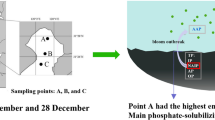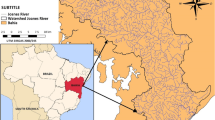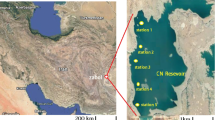Abstract
Eruption of blue-green algal blooms occurs frequently in eutrophic lakes and fish ponds, with associated unpleasant odor and horrid scums. In the present study, we conducted a pre-test experiment in 3 m3 outdoor concrete ponds to determine the optimum concentration of aluminum sulfate (alum) required for reduction of the cyanobacterial blooms without negative effect on fish growth. As a consequence, 10 mg L−1 alum was named as the optimum concentration that was applied in 1000 m3 earthen fish ponds. Obtained results showed that Secchi disc values significantly increased from 10 to 24 cm after 14 days of alum application. Alum-treated ponds showed a reduction in total phytoplankton counts by 94 and 96 % compared to the corresponding controls after 10 and 14 days, respectively. Abundance of blue-green algae in the treated ponds was decreased by 98 % compared to the corresponding control after 14 days of alum application. Consequently, dissolved oxygen, pH, total phosphorus, orthophosphate, and chlorophyll “a” content declined significantly. Our study revealed that using 10 mg L−1 of alum is an effective way to control cyanobacterial blooms in eutrophic waters, especially in fish ponds, without negative effect in water quality.

Similar content being viewed by others
References
Adeoye PA, Musa JJ, Akinyemi BA (2009) Design of aerated lagoon for fish pond wastewater treatment. AU J Tech 12(3):188–192
Ahmad MH, Abdelghany AE, Abdel-Tawwab M (2001) Phytoplankton dynamics in fertilized earthen ponds received supplemental feed at different timing for different periods. Egypt J Bot 41(1):79–98
American Public Health Association, APHA (1985) Standard methods for the examination of water and wastewater. 16th ed., Washington DC, pp. 1268
Anderson DM (1997) Turning back the harmful red tide. Nature 388:513–514
Arnold DE (1971) Ingestion, assimilation, survival and production by Daphina pulex fed on seven species of blue-green algae. Limnol Oceanogr 16(6):906–920
Babel S, Takizawab S (2011) Chemical pretreatment for reduction of membrane fouling caused by algae. Desalination 274(1–3):171–176
Barkoh A, Kurte GL, Begley DC, Fries LT (2013) Use of aluminum sulfate to reduce ph and increase survival in fingerling striped bass production ponds fertilized with nitrogen and phosphorus. N Am J Aquac 75:377–384
Bernardi R, Giussani G (1990) Are blue-green algae are a suitable food for zooplankton? An overview. Hydrobiologia 200–201(1):29–41
Boyd CE (1979) Water quality in warm water fish ponds. Auburn University, Agricultural Experiment Station. 359
Boyd CE (1995) Bottom soils, sediment, and pond aquaculture. Springer Press, New York, p 348
Boyd CE (1998) Pond aquaculture water quality management. Springer Press, New York, p 700
Brunson MW, Lutz CG, Durborow RM (1994) Algae blooms in commercial fish production ponds. Southern Regional Aquaculture Center (SRAC), No. 466
Burford M (1997) Phytoplankton dynamic in shrimp ponds. Aquac Res 28(5):351–360
Cooke GD, McComas MR, Waller DW, Kennedy RH (1977) The occurrence of internal phosphorus loading in two small, eutrophic, glacial lakes in northeastern Ohio. Hydrobiologia 56(2):129–135
Dodds WK, Bouska WW, Eitzmann JL, Pilger TJ, Pitts KL, Riley AJ, Schloesser JT, Thornbrugh DJ (2009) Eutrophication of U.S. freshwaters: analysis of potential economic damages. Environ Sci Technol 43(1):12–19
Drenner RW, Hambricht KD, Vinyard GL, Gophen M, Pollinger U (1987) Experimental study of size-selective phytoplankton grazing by a filter-feeding cichlid and the cichlid’s effects on plankton community structure. Limnol Oceanogr 32(5):1138–1144
El-Ayouty YM, El-Essawy AA, Said AA (1999) The assessment of water quality of Enan and El-Abbassa ponds, Egypt. Acta Hydrobiol 412:117–137
European Inland Fisheries Advisory Commission (1973) Water quality criteria for European freshwater fish. EIFAC Technical Paper, Rome
Falconer IR (2008) Health effects associated with controlled exposures to cyanobacterial toxins. In: Hudnell HK, Kenneth H (eds) Cyanobacterial harmful algal blooms: state of the science and research needs. Advances in experimental medicine and biology. Springer Press, New York, pp 607–612
Gerde JA, Yao L, Lio JY, Wen Z, Wang T (2014) Microalgae flocculation: impact of flocculant type, algae species and cell concentration. Algal Res 3:30–35
Green BW, El Nagdy Z, Hebicha H, Shaker I, Kenawy DA, El-Gamal AR (1995) Evaluation of Nile tilapia production systems in Egypt. CRSP Research Report 9591. Pond Dynamics/Aquaculture CRSP, Oregon State University, Corvallis, Oregon, 12 pp.
Holz JC, Hoagland KD (1999) Effects of phosphorus reduction on water quality: comparison of alum-treated and untreated portions of a hypereutrophic lake. Lake Reserv Manag 15(1):70–82
James WF, Barko JW, Taylor WD (1991) Effects of alum treatment on phosphorus dynamics in a north-temperate reservoir. Hydrobiologia 215:231–241
Jhingran VG (1995) Fish and fisheries of India. Hindustan Publishing Corporation of India, Delhi, pp 23–248
Joy CM, Balakrishnan KP, Ammini J (1990) Effect of industrial discharges on the ecology of phytoplankton production in the river Periyar (India). Water Res 24(6):787–796
KiØrboe T, Saiz E (1995) Planktivorous feeding in calm and turbulent environments, with emphasis on copepods. Mar Ecol Prog Ser 122:135–145
Koohestanian A, Hosseini M, Abbasian Z (2008) The separation method for removing of colloidal particles from raw water. Am Eurasian J Agric Environ Sci 4(2):266–273
Kunlasak K, Chitmanat C, Whangchai N, Promya J, Lebel L (2013) Relationships of dissolved oxygen with chlorophyll-a and phytoplankton composition in tilapia ponds. Int J Geosci 4(5B):46–53
Lembi CA (2000) Relative tolerance of mat-forming algae to copper. J Phycol 36(s3):43–44
Levasseur M, Therriault JC, Legendre L (1984) Hierarchical control of phytoplankton succession by physical factors. Mar Ecol Prog Ser 19:211–222
Lu K, Jin C, Dong S, Gu B, Bowen SH (2006) Feeding and control of blue-green algal blooms by tilapia (Oreochromis niloticus). Hydrobiologia 568:111–120
Lundgren VM, Roelke DL, Grover JP, Brooks BW, Prosser KN, Scott WC, Laws CA, Umphres GD (2013) Interplay between ambient surface water mixing and manipulated hydraulic flushing: implications for harmful algal bloom mitigation. Ecol Eng 60:289–298
Malecki-Brown L, John RW, Hans B (2010) Alum application to improve water quality in a municipal wastewater treatment wetland: effects on macrophyte growth and nutrient uptake. Chemosphere 79(2):186–192
Mason CF (2001) Biology of freshwater pollution, 4th edn. Prentice Hall, UK, p 400
Masson S, Angeli N, Guillard J, Pinel-Alloul B (2001) Diel vertical and horizontal distribution of crustacean zooplankton and young of the year fish in a sub-alpine lake: an approach based on high frequency sampling. J Plankton Res 23(10):1041–1060
McIntosh AW, Kevern NR (1974) Toxicity of copper to zooplankton. J Environ Qual 3(2):166–170
Miskimmin BM, Donahue WF, Watson D (1995) Invertebrate community response to experimental lime (Ca(OH)2) treatment of an eutrophic pond. Aquat Sci 57(1):20–30
Morrison CM, Wright JR (1999) A study of the histology of the digestive tract of the Nile tilapia. J Fish Biol 54(3):597–606
Paerl HW, Tucker CS (1995) Ecology of blue-green algae in aquaculture ponds. J World Aquacult Soc 26(2):109–131
Prescott GW (1962) Algae of the western Great Lake area with an illustrated key to the genera of desmids and freshwater diatoms. WM. C. Brown Company Publishers, Iowa
Prescott GW (1978) How to know the freshwater algae. WM. C. Brown Company Publishers, Iowa
Preston T, Stewart WD, Reynolds CS (1980) Bloom-forming cyanobacterium Microcystis aeruginosa overwinters on sediment surface. Nature 288:365–367
Sas H (1989) Lake restoration by reduction of nutrient loading: expectations, experiences, extrapolations. Academic Verlag Richarz, St Augustin, p 497
Schagerl M, Unterrieder I, Angeler D (2001) Allelopathic interactions among Anabaena torulosa (Cyanoprokaryota) and other algae isolated from Lake Neusiedlersee (Austria). Algol Stud 103:117–130
Seip KL (1994) Phosphorus and nitrogen limitation of algae biomass across trophic gradients. Aquat Sci 56:16–28
Sevrin-Reyssac J, Pletikosic M (1990) Cyanobacteria in fish ponds. Aquaculture 88(1):1–20
Shilo M (1967) Formation and mode of action of algal toxins. Bacteriol Rev 31(3):180–193
Sivonen K, Jones G (1999) Cyanobacterial toxins. In: Chorus I, Bartram J (eds) Toxic cyanobacteria in water: a guide to their public health consequences, monitoring and management. WHO, London
Smith DG (2001) Pennak’s freshwater invertebrates of the United States: Porifera to Crustacea, 4th edn. John Wiley & Sons, United States, p 638
Soltero RA, Nichols DG, Gasperino AF, Beckwith MA (1981) Lake restoration: Medical Lake, Washington. J Freshw Ecol 1(2):155–165
Syrett PJ (1981) Nitrogen metabolism of microalgae. Can Bull Fish Aquat Sci 210:182–210
Tseng KF, Huang JS, Liao IC (1991) Species control of microalgae in an aquaculture pond. Water Res 25(11):1431–1437
Tucker CS, D’Abramo LR (2008) Managing high pH in freshwater ponds. Southern Regional Aquaculture Center. SRAC Publication No.4604, USA
Uhlman D (1961) Über den Einfluss von Planktonorganismen auf ihr Milieu. Int Rev Gesamten Hydrobiol 46(1):115–129
Viessman W, Hammer MJ, Perez EM (2008) Water supply and pollution control, 8th edn. Pearson Prentice Hall, New York
Volk RB (2005) Screening of microalgal culture media for the presence of algicidal compounds and isolation and identification of two bioactive metabolites, excreted by the cyanobacteria Nostoc insulare and Nodularia harveyana. J Appl Phycol 17:339–347
Vollenweider RA, Talling JF, Westlake DF (1969) A manual on methods for measuring primary production in aquatic environments. International Biological Programme, Blackwell Scientific, Oxford, p 213
Welch EB, Schrieve GD (1994) Alum treatment effectiveness and longevity in shallow lakes. Hydrobiologia 275(276):423–431
Yang YF, Huang XF, Liu JK, Jiao NZ (2005) Effects of fish stocking on the zooplankton community structure in a shallow lake in China. Fish Manag Ecol 12(2):81–89
Yee KA, Prepas EE, Chambers PA, Culp JM, Scrimgeour G (2000) Impact of Ca(OH)2 treatment on macroinvertebrate communities in eutrophic hardwater lakes in the Boreal Plain region of Alberta: in situ and laboratory experiments. Can J Fish Aquat Sci 57(1):125–136
Yin C, Lan Z, Jin W (1989) Algal bloom control study in enclosure experimental system. Acta Sci Circumst Haunjing Kexue Xuebao 9(1):95–99
Acknowledgments
We thank Prof. Dr. Effat Shabana (Professor of Phycology, Faculty of Science, Cairo University, Egypt) and Mr. Mohammed Eid (Plant Pathology Department, University of Kentucky, Lexington, Kentucky, USA) for their contribution in writing the manuscript. We are grateful to the anonymous reviewers for suggesting insightful comments which led to a much improved manuscript. This work was funded by the Egyptian Ministry of Higher Education and Scientific Research (MHESR).
Conflict of interest
The authors declare that they have no competing interests.
Author information
Authors and Affiliations
Corresponding author
Additional information
Responsible editor: Philippe Garrigues
Rights and permissions
About this article
Cite this article
Dawah, A., Soliman, A., Abomohra, A.EF. et al. Influence of alum on cyanobacterial blooms and water quality of earthen fish ponds. Environ Sci Pollut Res 22, 16502–16513 (2015). https://doi.org/10.1007/s11356-015-4826-7
Received:
Accepted:
Published:
Issue Date:
DOI: https://doi.org/10.1007/s11356-015-4826-7




